
Cast * Interesting Facts * Production Details * The Story of the Production * Differences with the Grimms' Story

Cast * Interesting Facts * Production Details * The Story of the Production * Differences with the Grimms' Story
Directed by: David Hand
Written by: Dorothy Ann Blank & Richard Creedon
Music by: Frank Churchill, Leigh Harline, Larry Morey, Paul
J. Smith
Released on: December 21, 1937
Running Time: 83 minutes
Budget: $500,000
Box-Office: $184.925 million in the U.S. ($41.634 million
of which come from the 1993 re-release)
Note: Snow White earned $8 millions in its first release,
a phenomenal sum at the time, considering the average price for theater
admission in the United States was 25 cents -and a heavy percentage of
those seeing Snow White were children admitted for a dime.
Snow White... Adriana Caselotti
Prince... Harry Stockwell
The Queen/WitchMoroni... Lucille La Verne
Magic Mirror... Olsen
Sneezy... Billy Gilbert (I)
Sleepy & Grumpy... Pinto Colvig
Happy... Otis Harlan
Bashful... Scotty Mattraw
Doc... Roy Atwell
Huntsman... Stuart Buchanan
 Adriana
Caselotti (1916-1997) was born into an operatic family - her father Guido,
an immigrant from Italy, taught music in New York City, her mother Maria
(from Naples) sang at the Royal Opera, and a sister Louise was a noted
opera singer and voice teacher. She was 18 when Walt Disney personally
choose her for the voice of Snow White in his first full length animated
feature Snow White and the Seven Dwarfs (1937). He was looking for
a fresh and natural voice, and asked her father if any of his students
might be suitable, but on hearing Adriana's voice realized his search was
over. It was the days of studio contracts and indenture, and Walt wanted
to keep the mystery of the Snow White voice, so except for a bit part in
The
Wizard of Oz (1939) she was in no other film - when Jack Benny wished
to have her appear on his radio show, Walt refused - he owned the voice
and it could be used nowhere else. Adriana tried opera singing, and invested
in real estate and stock market, while living a full life (four husbands,
thrice widowed), always active in the publicity surrounding the many re-releases
of Snow White.
Adriana
Caselotti (1916-1997) was born into an operatic family - her father Guido,
an immigrant from Italy, taught music in New York City, her mother Maria
(from Naples) sang at the Royal Opera, and a sister Louise was a noted
opera singer and voice teacher. She was 18 when Walt Disney personally
choose her for the voice of Snow White in his first full length animated
feature Snow White and the Seven Dwarfs (1937). He was looking for
a fresh and natural voice, and asked her father if any of his students
might be suitable, but on hearing Adriana's voice realized his search was
over. It was the days of studio contracts and indenture, and Walt wanted
to keep the mystery of the Snow White voice, so except for a bit part in
The
Wizard of Oz (1939) she was in no other film - when Jack Benny wished
to have her appear on his radio show, Walt refused - he owned the voice
and it could be used nowhere else. Adriana tried opera singing, and invested
in real estate and stock market, while living a full life (four husbands,
thrice widowed), always active in the publicity surrounding the many re-releases
of Snow White.
The Queen was the last role of Lucille La Verne (1872-1945), one
of many vengeful characters she played during her career.
![]() In the original
Brothers Grimm fairy tale, the dwarfs are indistinct, interchangeable characters.
For Disney's version, more than 50 names and personalities were thought
up -- including Tubby, Burpy, and Biggy-Wiggy -- before the final Seven
Dwarf names were chosen.
In the original
Brothers Grimm fairy tale, the dwarfs are indistinct, interchangeable characters.
For Disney's version, more than 50 names and personalities were thought
up -- including Tubby, Burpy, and Biggy-Wiggy -- before the final Seven
Dwarf names were chosen.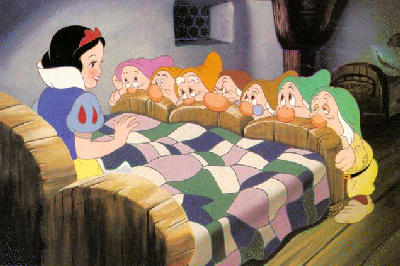
![]() Snow White
was not the first feature-length animated film, as has sometimes been claimed.
It was, however, the first American feature-length animated film, the first
feature-length animated film made by a studio, rather than an independent
film-maker, and the first Technicolor feature.
Snow White
was not the first feature-length animated film, as has sometimes been claimed.
It was, however, the first American feature-length animated film, the first
feature-length animated film made by a studio, rather than an independent
film-maker, and the first Technicolor feature.
![]() Walt Disney
used Rouben Mamoulian's 1931 Dr. Jekyll and Mr. Hyde to show his
animators how he wanted the transformation of the Wicked Queen to look
in Snow White and the Seven Dwarfs.
Walt Disney
used Rouben Mamoulian's 1931 Dr. Jekyll and Mr. Hyde to show his
animators how he wanted the transformation of the Wicked Queen to look
in Snow White and the Seven Dwarfs.
![]() At the movie's
December 21, 1937, premiere at Hollywood's Carthay Circle Theater, the
celebrity-packed audience rose to its feet and cheered at the film's conclusion.
At the movie's
December 21, 1937, premiere at Hollywood's Carthay Circle Theater, the
celebrity-packed audience rose to its feet and cheered at the film's conclusion.
![]() At that same
premiere, Walt Disney was so flustered he couldn't remember the names of
the Seven Dwarfs!
At that same
premiere, Walt Disney was so flustered he couldn't remember the names of
the Seven Dwarfs!
![]() You might notice
in one scene that Snow White does not kiss all seven dwarves. The
reason why is that the feature was running too long, and the animators
had not completed all 7 dwarves getting kissed so Happy was left out.
You might notice
in one scene that Snow White does not kiss all seven dwarves. The
reason why is that the feature was running too long, and the animators
had not completed all 7 dwarves getting kissed so Happy was left out.
![]() While reviewing
a nearly completed version of the film, Walt Disney noticed the when the
Prince leaned over to kiss Snow White in her glass coffin, he shimmied.
Something had gone wrong in the camera work or the animation. Because of
the cost of fixing the problem was so high, the film was released with
the mistake.
While reviewing
a nearly completed version of the film, Walt Disney noticed the when the
Prince leaned over to kiss Snow White in her glass coffin, he shimmied.
Something had gone wrong in the camera work or the animation. Because of
the cost of fixing the problem was so high, the film was released with
the mistake.
![]() Other goofs:
Other goofs:
- Dopey's hand playing the drums when he is also dancing with Snow
White.
- Doc's lantern disappears when they reach the house after working
in the mine.
- Dopey breaks off the front door handle and seconds later it's
there again.
- When the dwarfs reach the house after working, they drop some
tools and scurry behind the trees. A couple of minutes later they have
tools again.
![]() Non-English
versions show the names on the dwarfs' beds and the witch queen's book
of magic written in the language of the country of release (Italian in
Italy, French in France, etc.)
Non-English
versions show the names on the dwarfs' beds and the witch queen's book
of magic written in the language of the country of release (Italian in
Italy, French in France, etc.)
![]() The 1992 restoration
of "Snow White" marked a first in the use of digital technology in film.
Never before had every frame of an entire film been converted to digital
imagery, manipulated in some way, and then printed back out to film. Not
only does the film reside on special Kodak intermediate film stock, it
is also stored on digital tape.
The 1992 restoration
of "Snow White" marked a first in the use of digital technology in film.
Never before had every frame of an entire film been converted to digital
imagery, manipulated in some way, and then printed back out to film. Not
only does the film reside on special Kodak intermediate film stock, it
is also stored on digital tape.
![]() In 1993, USA
Today computed that if one adjusted for inflation and escalating box-office
prices, Snow White and the Seven Dwarfs' theatrical earnings would
exceed $6 billion! Strictly adjusted to inflation, Snow White still
is the highest-grossing animated film ever: its domestic gross of $80.89
million corresponding to $242.24 million. A close second is 101
Dalmatians (1961) with $68.65/$240.4 million, followed by Fantasia
(1940) with $41.66/$240.4; The Lion King
(1994) only holds the fourth position!
In 1993, USA
Today computed that if one adjusted for inflation and escalating box-office
prices, Snow White and the Seven Dwarfs' theatrical earnings would
exceed $6 billion! Strictly adjusted to inflation, Snow White still
is the highest-grossing animated film ever: its domestic gross of $80.89
million corresponding to $242.24 million. A close second is 101
Dalmatians (1961) with $68.65/$240.4 million, followed by Fantasia
(1940) with $41.66/$240.4; The Lion King
(1994) only holds the fourth position!
![]() When a newly
restored version of the film was released on video in 1994, it outsold
Jurassic
Park.
When a newly
restored version of the film was released on video in 1994, it outsold
Jurassic
Park.
![]() The October
9, 2001 Platinum
Collection DVD contained 15 hours of material on two discs, which include
the movie itself (in four languages), a "making of" documentary, an interactive
Dopey game, the deleted songs "You're Never Too Old To Be Young", and an
original recording of "Some Day My Prince Will Come", performed by Barbra
Streisand. Bob Chapek, president of Buena Vista Home Entertainment, Disney's
video distribution arm, described the release as "the first truly immersive
experience."
The October
9, 2001 Platinum
Collection DVD contained 15 hours of material on two discs, which include
the movie itself (in four languages), a "making of" documentary, an interactive
Dopey game, the deleted songs "You're Never Too Old To Be Young", and an
original recording of "Some Day My Prince Will Come", performed by Barbra
Streisand. Bob Chapek, president of Buena Vista Home Entertainment, Disney's
video distribution arm, described the release as "the first truly immersive
experience."
![]() The 2001 video,
which was released in 95 percent of foreign markets, seized the crown as
the top-selling video and DVD animated title of all time overseas, notching
sales of 8 million units. Adding in the sales for the original release
in 1994, the cumulative total is 26 million units, outstripping The
Lion King, which sold 24 million copies. At an average retail price
of $20, the 8 million units represent $160 million in retail revenues.
Snow
White also ranks as the second-best-selling home entertainment title
of any kind abroad, behind Titanic.
The 2001 video,
which was released in 95 percent of foreign markets, seized the crown as
the top-selling video and DVD animated title of all time overseas, notching
sales of 8 million units. Adding in the sales for the original release
in 1994, the cumulative total is 26 million units, outstripping The
Lion King, which sold 24 million copies. At an average retail price
of $20, the 8 million units represent $160 million in retail revenues.
Snow
White also ranks as the second-best-selling home entertainment title
of any kind abroad, behind Titanic.
 |
 |
 |
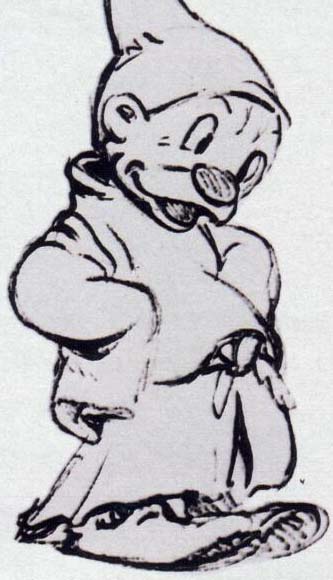 |
![]() Walt Disney had
started his company in the 1920s, making short animated cartoons, but he
was never able to attain much financial success because theaters just didn't
pay enough for cartoon rentals. He determined that to be successful, he
would have to make a full-length feature instead. "What?" said his critics.
"People will go mad sitting in a theater for a full 80 to 90 minutes watching
the bright color animation on the screen." But Walt knew they were wrong.
While traveling in Europe, he had found theaters where 8 to 10 Disney short
cartoons were being shown together, and audiences loved them, staying for
the entire screening. He reasoned that if they would do that with Mickey
Mouse, they would certainly sit still for a well-made full-length film
with an intriguing story.
Walt Disney had
started his company in the 1920s, making short animated cartoons, but he
was never able to attain much financial success because theaters just didn't
pay enough for cartoon rentals. He determined that to be successful, he
would have to make a full-length feature instead. "What?" said his critics.
"People will go mad sitting in a theater for a full 80 to 90 minutes watching
the bright color animation on the screen." But Walt knew they were wrong.
While traveling in Europe, he had found theaters where 8 to 10 Disney short
cartoons were being shown together, and audiences loved them, staying for
the entire screening. He reasoned that if they would do that with Mickey
Mouse, they would certainly sit still for a well-made full-length film
with an intriguing story.
![]() Before embarking
on their first feature length film, Disney artists needed experience in
animating the human figure. A 1934 Silly Symphony,
The Goddess
of Spring, was designed to test their skills in this area.
Meanwhile, rough versions of characters for Snow White began to appear
at the Studio. This is the only feature in which transparent colors were
employed for the background paintings. Later gouache became the usual
medium.
Before embarking
on their first feature length film, Disney artists needed experience in
animating the human figure. A 1934 Silly Symphony,
The Goddess
of Spring, was designed to test their skills in this area.
Meanwhile, rough versions of characters for Snow White began to appear
at the Studio. This is the only feature in which transparent colors were
employed for the background paintings. Later gouache became the usual
medium.
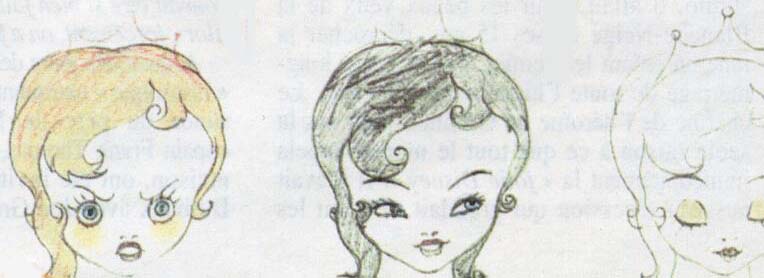
![]() That same year,
Walt Disney gathered his artists on a Studio soundstage one evening (after
giving them all money to go out and get their dinner first). The animators
were all amazed as Walt explained they were going to start working on an
animated feature. Despite first thoughts that they weren’t capable of that
kind of production, the animators were then transfixed as Walt took the
next hour and a half to tell the entire story of Snow White And The Seven
Dwarfs, acting out the parts of all the characters. Walt’s performance
was enough to persuade the artists it could be done, and they left the
room just as convinced as Walt that they could make a breakthrough motion
picture.
That same year,
Walt Disney gathered his artists on a Studio soundstage one evening (after
giving them all money to go out and get their dinner first). The animators
were all amazed as Walt explained they were going to start working on an
animated feature. Despite first thoughts that they weren’t capable of that
kind of production, the animators were then transfixed as Walt took the
next hour and a half to tell the entire story of Snow White And The Seven
Dwarfs, acting out the parts of all the characters. Walt’s performance
was enough to persuade the artists it could be done, and they left the
room just as convinced as Walt that they could make a breakthrough motion
picture.
![]() For the next three
years the Disney staff toiled. They were breaking new ground and learning
as they proceeded, but everything started to fall into place. Frequent
story meetings were held and a stenographer took down all that was said
verbatim. The artists could then refer to the decisions that were made
when they returned to their drawing tables. While the animators were drawing
the characters, other artists were styling and painting elaborate backgrounds
and composers were writing a catchy musical score.
For the next three
years the Disney staff toiled. They were breaking new ground and learning
as they proceeded, but everything started to fall into place. Frequent
story meetings were held and a stenographer took down all that was said
verbatim. The artists could then refer to the decisions that were made
when they returned to their drawing tables. While the animators were drawing
the characters, other artists were styling and painting elaborate backgrounds
and composers were writing a catchy musical score.
![]() More than
750 artists worked on the picture, creating at least one million drawing,
of which over 250,000 were used. Studio chemists in the Disney paint
laboratories ground their own pigments from special formulas and mixed
1,500 colors and shades for the characters and backgrounds. The multiplane
camera, invented and developed by Walt Disney Studio technicians, first
reached a high degree of perfection in Snow White and the Seven Dwarfs.
With is, animated scenes achieved a three-dimensional quality because characters
and backgrounds could be photographed on several levels or planes.
More than
750 artists worked on the picture, creating at least one million drawing,
of which over 250,000 were used. Studio chemists in the Disney paint
laboratories ground their own pigments from special formulas and mixed
1,500 colors and shades for the characters and backgrounds. The multiplane
camera, invented and developed by Walt Disney Studio technicians, first
reached a high degree of perfection in Snow White and the Seven Dwarfs.
With is, animated scenes achieved a three-dimensional quality because characters
and backgrounds could be photographed on several levels or planes.
![]() Several scenes were
planned, and some animated, but cut from the final version of Snow White:-
The queen holds the prince in the dungeon and uses her magic to make skeletons
dance for his amusement.
Several scenes were
planned, and some animated, but cut from the final version of Snow White:-
The queen holds the prince in the dungeon and uses her magic to make skeletons
dance for his amusement.
- Fantasy sequence accompanying "Some Day My Prince Will Come" in
which Snow White imagines herself dancing with her prince in the clouds
beneath a sea of stars
- Dwarves building Snow White a bed with help from woodland creatures
(this was partially animated).
- The song "Music in Your Soup" where the dwarves sing about the
soup that Snow White had just made them (which was fully animated).
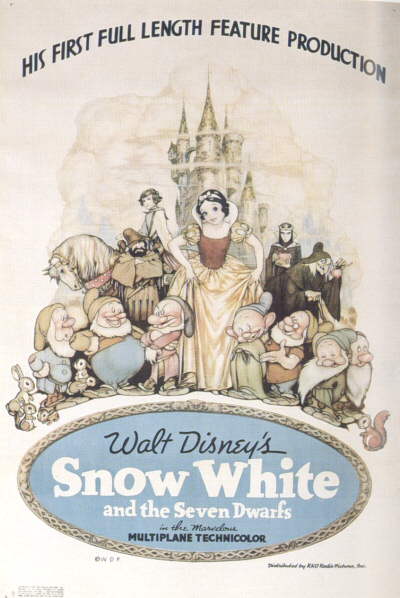
![]() Fifty ideas for the dwarves' names and personalities were listed in the
film's proposal; the list included all of the names finally included except
Dopey and Doc (Dopey being the last to be developed). Some of the dwarves
were: Awful, Biggy, Blabby, Dirty, Gabby, Gaspy, Gloomy, Hoppy, Hotsy,
Jaunty, Jumpy, Nifty, and Shifty. Sneezy was a last-minute replacement
for Jumpy.
Fifty ideas for the dwarves' names and personalities were listed in the
film's proposal; the list included all of the names finally included except
Dopey and Doc (Dopey being the last to be developed). Some of the dwarves
were: Awful, Biggy, Blabby, Dirty, Gabby, Gaspy, Gloomy, Hoppy, Hotsy,
Jaunty, Jumpy, Nifty, and Shifty. Sneezy was a last-minute replacement
for Jumpy.
![]() Convinced that it
would fail, the Hollywood film industry labeled the film "Disney's Folly."
Convinced that it
would fail, the Hollywood film industry labeled the film "Disney's Folly."
![]() The film was completed
in December 1937 and premiered on December 21 at the Carthay Circle Theater
in Hollywood. Walt Disney was entranced -- all of Hollywood had turned
out for a cartoon. He needn’t have worried...
The film was completed
in December 1937 and premiered on December 21 at the Carthay Circle Theater
in Hollywood. Walt Disney was entranced -- all of Hollywood had turned
out for a cartoon. He needn’t have worried...
![]() Snow White
earned $8 millions in its first release, a phenomenal sum at the time,
considering the average price for theater admission in the United States
was 25 cents -and a heavy percentage of those seeing Snow White were children
admitted for a dime! The film became the world’s highest-grossing film
until Gone With The Wind was released a few years later. It
was a critical success as well, with the Academy of Motion Picture Arts
and Sciences giving Snow White a special award in 1939: nine-year-old
Shirley Temple made the presentation to Walt Disney of a large golden Oscar
and seven miniature replicas.
Snow White
earned $8 millions in its first release, a phenomenal sum at the time,
considering the average price for theater admission in the United States
was 25 cents -and a heavy percentage of those seeing Snow White were children
admitted for a dime! The film became the world’s highest-grossing film
until Gone With The Wind was released a few years later. It
was a critical success as well, with the Academy of Motion Picture Arts
and Sciences giving Snow White a special award in 1939: nine-year-old
Shirley Temple made the presentation to Walt Disney of a large golden Oscar
and seven miniature replicas.
![]() The eight songs
of the movie have been translated into thirteen languages and are well
known throughout the world, wherever this record-breaking picture has played.
The film was re-released to theaters in 1992 and to video in 1993. It went
on moratorium April 28, 1995.
The eight songs
of the movie have been translated into thirteen languages and are well
known throughout the world, wherever this record-breaking picture has played.
The film was re-released to theaters in 1992 and to video in 1993. It went
on moratorium April 28, 1995.

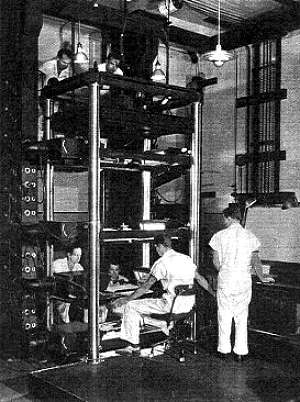 Walt
Disney came to Hollywood in 1923 and began pioneering the field of motion
picture animation with his Alice Comedies, Oswald the Lucky Rabbit, Mickey
Mouse and "Silly Symphony" shorts.
Walt
Disney came to Hollywood in 1923 and began pioneering the field of motion
picture animation with his Alice Comedies, Oswald the Lucky Rabbit, Mickey
Mouse and "Silly Symphony" shorts.
In 1928, Mickey Mouse became Al Jolson's cartoon counterpart when he appeared in the synchronized sound cartoon "Steamboat Willie". The following year, Disney premiered "The Skeleton Dance," the first in a long line of Silly Symphonies that provided a testing ground for new ideas and techniques. Through these innovative cartoons, he was able to experiment with color ("Flowers and Tree"), the integration of story, personality development and music ("Three Little Pigs"), the perceived dimensions of the multiplane camera ("The Old Mill") and refining a realistic human character ("The Goddess of Spring"). All of the above were necessary steps in preparing his team for the challenges that lay ahead.
Disney had been thinking about a feature-length cartoon for a long time. In the early 1930's, he and Mary Pickford had discussed a production of "Alice in Wonderland" with the actress in the title role and the rest of the cast to be drawn by Walt's artists. A similar project with Will Rogers in a version of "Rip Van Winkle" also fell be the wayside.
The idea to do a feature film was also an economic fact of life. The introduction of double-features during the 1930's was having the effect of squeezing Disney's cartoon "fillers" off the screen -- victims of running time.
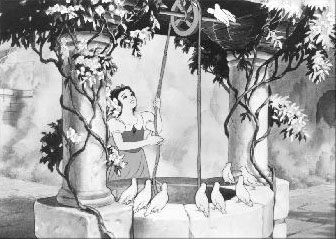 "One
night in 1934," recalls veteran Disney art director and designer Ken Anderson,
"we came back to the studio to work after dinner, and Walt called 40 of
us on to the small recording stage. We all sat in folding chairs, the lights
went down, and Walt spent the next four hours telling us the story of Snow
White and the Seven Dwarfs. He didn't just tell the story, he acted out
each character, and when he got to the end he told us that was going to
be our first feature. It was a shock to all of us because we knew how hard
it was to do a cartoon short. He was doing something no other studio had
ever attempted, but his excitement over 'Snow White' inspired us all."
"One
night in 1934," recalls veteran Disney art director and designer Ken Anderson,
"we came back to the studio to work after dinner, and Walt called 40 of
us on to the small recording stage. We all sat in folding chairs, the lights
went down, and Walt spent the next four hours telling us the story of Snow
White and the Seven Dwarfs. He didn't just tell the story, he acted out
each character, and when he got to the end he told us that was going to
be our first feature. It was a shock to all of us because we knew how hard
it was to do a cartoon short. He was doing something no other studio had
ever attempted, but his excitement over 'Snow White' inspired us all."
Veteran animator Ollie Johnston was also present that fateful and electric evening. "It took guts to do what Walt did," says Johnston. "The story is based on the idea that the Queen is going to murder this girl. That's one drawing killing another drawing. Walt convinced us that this could be done so that it would be believable and we all believed him."
A training program for the artists was started informally at animator Art Babbit's home and later moved to the studio when it became hugely popular. Don Graham, a renowned instructor from Chouinard Art Institute, became involved in the animator's training. He taught them how to make simple and direct statements that could communicate and say something. His action analysis classes with moving models proved quite helpful and, as a result, Snow White was able to overcome the stiffness and awkward motions that had plagued the female human character in "The Goddess of Spring."
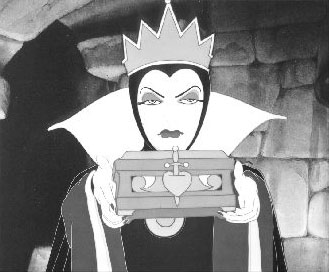 During
the course of the production, live models were photographed for the animators
to study so they might achieve realistic actions. Marjorie Belcher (who
later became Marge Champion of the famous Marge and Gower Champion dance
team) pantomimed the actions of Snow White while Louis Hightower stood
in for the prince. Layout man Ken O'Connor was given the onerous task of
tracing the live-action directly off the Moviola. These tracings
were then used as a loose guide by the animators. Proportions of figures
and live-action timing were altered to avoid the stilted, unreal look that
direct copying would have created. In fact, the size of Snow White's head
is nearly double that of the human model while her waist was reduced to
acrtoon proportions.
During
the course of the production, live models were photographed for the animators
to study so they might achieve realistic actions. Marjorie Belcher (who
later became Marge Champion of the famous Marge and Gower Champion dance
team) pantomimed the actions of Snow White while Louis Hightower stood
in for the prince. Layout man Ken O'Connor was given the onerous task of
tracing the live-action directly off the Moviola. These tracings
were then used as a loose guide by the animators. Proportions of figures
and live-action timing were altered to avoid the stilted, unreal look that
direct copying would have created. In fact, the size of Snow White's head
is nearly double that of the human model while her waist was reduced to
acrtoon proportions.
Production on Snow White and the Seven Dwarfs began in 1934 and was completed in 1937. More than 750 Disney artists worked on the film during those four years. Included were 32 animators, 102 assistants, 107 in-betweeners (artists who fill in bits of action between the animators' key drawings), 20 layout men, 25 background artists, 65 special effects animators (who draw smoke, water, clouds and other effects) and 158 professionals adept at inking and painting the cartoon figures on transparent celluloid sheets for reproduction by the Disney multiplane camera.
The movie is composed of more that 250,000 drawings with a musical background that was provided by an orchestra of 80 musicians. It has been estimated that some two million drawings and sketches were made during the production of the film.
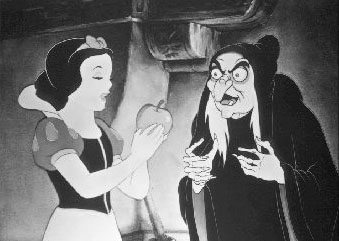 The
multiplane camera, invented and developed by technicians at The Walt Disney
Studios, first reached a high degree of perfection with Snow White and
the Seven Dwarfs. The camera was designed to endow certain animated scenes
with a three-dimensional quality by photographing the cartoon characters
working within painted backgrounds on several levels or planes of glass.
Each plane may be lighted separately for effect, moved individually or
jointly, closer to or farther from a camera lens, or at different speeds.
It was initially used in a cartoon short, Walt Disney's "The Old Mill"
(1937), and both the technology and the short won separate Academy Awards.
The
multiplane camera, invented and developed by technicians at The Walt Disney
Studios, first reached a high degree of perfection with Snow White and
the Seven Dwarfs. The camera was designed to endow certain animated scenes
with a three-dimensional quality by photographing the cartoon characters
working within painted backgrounds on several levels or planes of glass.
Each plane may be lighted separately for effect, moved individually or
jointly, closer to or farther from a camera lens, or at different speeds.
It was initially used in a cartoon short, Walt Disney's "The Old Mill"
(1937), and both the technology and the short won separate Academy Awards.
It took months of research by studio chemists and the mixing of 1,500 paint colors and shades to determine the final hues to be used for painting characters and backgrounds in the color by Technicolor film. All of the pigments used in the production were ground and mixed from special formulas within the Disney paint laboratory.
Last, but not least, the women in the ink-and-paint department devised
their own unique method for making Snow White's face seem more natural
. It was rumored that the women were unhappy with Snow White's ultra red
cheeks and harsh hair line. They altered this by applying real rouge and
other assorted make-up directly to the cel. Walt conceded that it looked
great but was concerned that they know exactly where to put it on each
drawing. One of the inkers replied, "Mr. Disney, what do you think we've
been doing all our lives."
RESTORING AND PRESERVING SNOW WHITE
 For
the 50th anniversary re-release of Snow White and the Seven Dwarfs, The
Walt Disney Studios supervised a major restoration of the film's original
nitrate negative through YCM Labs in Burbank, one of the industry's top
specialty labs whose restoration credits include Gone With the Wind and
hundreds of other classic titles for the UCLA Film Archives, Disney and
many other studios. At that time, the original film elements -- successively
exposed yellow, cyan and magenta images on the same strip of nitrate film
-- were hand cleaned and polished frame-by-frame. Torn perforations, patches
and tears were inspected and repaired. From there, a new master positive
was created using a contact printer (as opposed to an optical printer)
to assure the truest transfer of the image from the original negative.
The latter process was able to eliminate many fine scratches that had accumulated
over the years as well as some defects in the original source material.
With modern fine grain film emulsions and precision lenses, the result
was an improvement over any previous release prints, including the original.
For
the 50th anniversary re-release of Snow White and the Seven Dwarfs, The
Walt Disney Studios supervised a major restoration of the film's original
nitrate negative through YCM Labs in Burbank, one of the industry's top
specialty labs whose restoration credits include Gone With the Wind and
hundreds of other classic titles for the UCLA Film Archives, Disney and
many other studios. At that time, the original film elements -- successively
exposed yellow, cyan and magenta images on the same strip of nitrate film
-- were hand cleaned and polished frame-by-frame. Torn perforations, patches
and tears were inspected and repaired. From there, a new master positive
was created using a contact printer (as opposed to an optical printer)
to assure the truest transfer of the image from the original negative.
The latter process was able to eliminate many fine scratches that had accumulated
over the years as well as some defects in the original source material.
With modern fine grain film emulsions and precision lenses, the result
was an improvement over any previous release prints, including the original.
Time and technology marches on and now, for the 1993 re-release, Snow White and the Seven Dwarfs becomes the first motion picture to ever be restored and preserved with new digital technology. As a result, moviegoers will see a new and improved Snow White with a picture quality that has never before been possible.
The story behind this latest restoration began in 1991, when Kodak exhibited its High Resolution Electronic Intermediate System (HREIS), which was later renamed Cineon, and installed at Cinesite in Burbank, California. Disney's manufacturing vice president Jeff Miller and vice president, new technologies, Bob Lambert, were sufficiently impressed with this advanced laser scan digital compositing technology and subsequently proposed that the process be adapted to restore Snow White. Since Kodak originally envisioned HREIS as a means of re-compositing shorter special effects sequences and not entire features, additional R & D was needed to meet the needs of this larger undertaking. With Disney's cooperation, Kodak's Cineon completed development of the required restoration tools and significantly greater capacity requirements. Oscar-winner Ed Jones (adding his vast experience from ILM) became Kodak's Cinesite president and assigned Bruno George (also of ILM and Boss Films) as project manager. Jerry Pooler, Tom Smith and Gil Gagnon were the project coordinators.
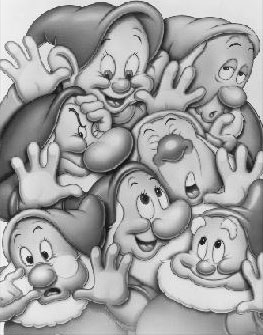 With
creative input from Disney — Tim Hauser (Feature Animation), Harrison Ellenshaw
and Ray Scalice (Buena Vista Visual Effects) and Jim Bice (Theme Park Films)
— primary emphasis was placed on maintaining and preserving the film's
original artistic integrity. With that in mind, the 700 scenes that comprise
Snow White were critically analyzed one frame at a time, to determine even
minute problems and best methods for digital restoration.
With
creative input from Disney — Tim Hauser (Feature Animation), Harrison Ellenshaw
and Ray Scalice (Buena Vista Visual Effects) and Jim Bice (Theme Park Films)
— primary emphasis was placed on maintaining and preserving the film's
original artistic integrity. With that in mind, the 700 scenes that comprise
Snow White were critically analyzed one frame at a time, to determine even
minute problems and best methods for digital restoration.
Using Kodak's Cineon system, imperfections on the original negative such as cel dirt, reflections from the glass platen and bumping and flickering have been largely and selectively eliminated.
From an audio standpoint, multiple Academy Award-nominated sound
re-recording mixer Terry Porter (Beauty and the Beast, Aladdin, the
restoration of Fantasia and Pinocchio) headed up a team which cleaned up
and upgraded the film's original soundtrack to approximate Dolby Stereo.
Although the original sound for Snow White was not recorded in stereo,
Porter credits the "superior quality of the original soundtrack elements"
as making his job possible. Using a combination of "sound" judgment and
new technology, Porter was able to add greater depth and specific direction
to the film's sound. In particular scenes like the heroine's escape through
the haunted forest and the climactic storm sequence, the soundtrack gives
the perception of surround effects and offers a richness that was never
there before.
DIFFERENCES WITH THE GRIMMS' STORY
The Grimms collected the story in 1810 and recorded it as they heard it, without altering it. This 1810 manuscript was never published, though, and only discovered decades after their death. By the time the Grimms published their first edition in two parts (1812 / 1814), they had already altered the tale. Suddenly the father is absent from the tale, and it is an anonymous and unrelated prince who rescues Snow White. The incest was removed by the Grimms because it conflicted rather heavily with their Christian mores.
A few years later when they published the second edition (their collection was wildly popular and sold out quickly, running through seven editions in its lifetime), the mother had become a stepmother. It seems the Grimms did not like the notion of a family so dysfunctional that a mother would kill her own daughter for such superficial reasons.
Still, when Walt Disney decided to adapt this tale, he made a few changes. Some of the differences with the Grimms' story include that:
|
||||||||||||